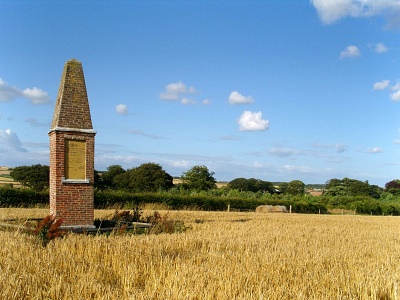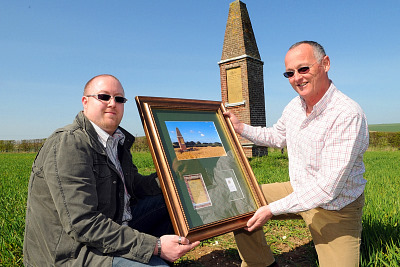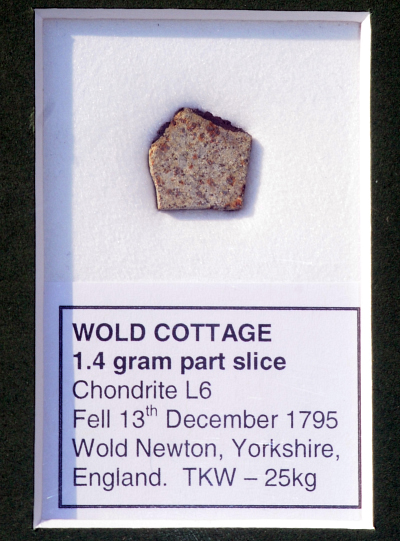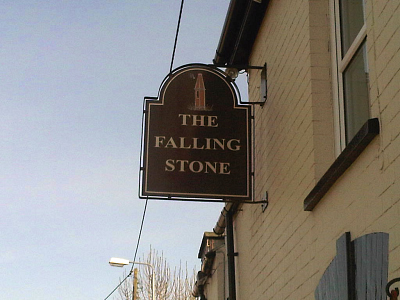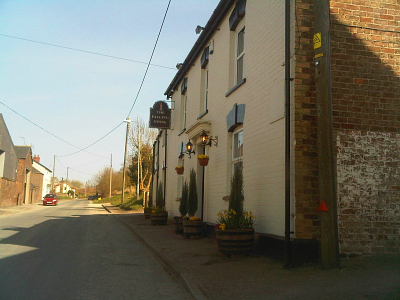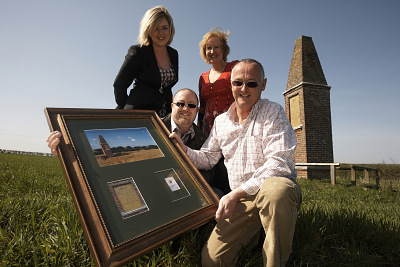IMCA Insights – June 2010
A Meteorite Homecoming
by Martin Goff
The story of the Wold Cottage meteorite and the role it occupies in the history of meteoritics cannot be overestimated. This historic meteorite was one of a few famous falls on a timeline from Barbotan in 1790 culminating in L’Aigle in 1803 that led to the general acceptance that stones do indeed fall from the sky and not only that, but that they come from space. Before moving on to the recent “meteorite homecoming” concerning the Wold Cottage meteorite I thought that I would refresh people’s memory on this historic fall.
Monument marking the
exact location of the Wold Cottage fall with
The Wold Cottage visible in the middle right. Photo by Martin Goff.
On 13 December 1795, a 25 kg stone fell in a field by the Wold Cottage
in the village of Wold Newton, East Yorkshire. It was a mild and
overcast Sunday when, at about 3:00 in the afternoon, several people in
the area heard something whizz through the air followed by a series of
explosions described as like gunfire at sea (Marvin 1996). A
seventeen-year-old ploughman called John Shipley saw a black stone
emerge from the clouds and fall to the ground about 30 feet from where
he was standing. He rushed to the spot and found a large stone that lay
in a pit in the soil and had impacted into the underlying limestone. He
described it as warm and smoking and smelling of sulphur. He was
assisted by two other workers in extracting the stone from the impact
pit (Burke 1986).
Major Edward Topham owned the Wold Cottage and the land surrounding it
and was also the employer of John Shipley. Topham was not actually
present when the meteorite fell as he was away in London. He returned
home soon after the event and wrote a letter detailing the fall and
accounts taken from his workers to a Mr. James Boaden, managing editor
of the Oracle newspaper in London. This letter was published in the 12
February edition of the paper. Topham was also a local Magistrate, and
in this role he obtained sworn statements from the three eyewitnesses
and interviewed numerous other persons who had heard sounds in the area
at the time. Topham wrote:
"All these witnesses who saw it fall, agree perfectly in their account
of the manner of its fall, and that they saw a dark body passing through
the air, and ultimately strike the ground: and though, from their
situations and characters in life, they could have no possible object in
detailing a false account of this transaction, I felt so compelled to
give this matter every degree of authenticity that, as a magistrate, I
took their account upon oath immediately on my return into the country.
I saw no reason to doubt any of their evidence after the most minute
investigation of it."
Topham later arranged to exhibit the stone in Piccadilly, London, across
from the well-known Gloucester Coffee House. Anyone who was prepared to
pay the entrance fee of 1 shilling was able to see the stone itself and
also the original testimonies of Topham and his workers. They also
received a leaflet as part of the entry fee with an engraving of the
stone and a written account of the story (Pillinger and Pillinger 1996).
Someone who definitely paid their 1 shilling was an Edward King, Fellow
of the Royal Society and one time President of the Antiquarian Society.
King published a paper whereby he made comparisons between the Siena
stone and that of the Wold Cottage stone, noting similarities in
substance and of the metallic grains. King has not been widely
acknowledged with making these observations which were made prior to
Edward Howard’s later chemical analyses (Pillinger and Pillinger 1996).
Martin Goff
presenting the framed specimen of Wold Cottage to
Derek Gray with the monument in the background.
Photo courtesy of Simon Kench (PPA Ltd).
It was also while the
meteorite was being exhibited in London that Sir Joseph Banks, President
of the Royal Society, saw the stone, noticed the similarity to his
specimen from the Siena fall, and acquired a sample. Exactly how this
sample was obtained by Banks we do not know, but it was possibly from
Topham himself. This sample of Wold Cottage and also samples of Siena,
among other meteorites, found their way from Banks to Edward Howard.
Howard was a young, gifted, and open-minded British chemist. He
separated the samples into magnetic grains of metal, reddish iron
sulphides, “curious globules,” and fine-grained matrix material. When
examining and comparing these components, he found striking similarities
in their mineralogy, texture, and chemical composition. He said, “These
stones, although they have not the smallest analogy with any of the
mineral substances already known, either of a volcanic or any other
nature, have a very peculiar and striking analogy with each other." He
went on to confirm the presence of nickel in the metallic grains in the
stone meteorites and also in so called “native irons” he examined
(Marvin 2001). These stones and irons that were of differing types, had
fallen in different countries, and at different times all had one thing
in common—the presence of nickel.
In 1799 Topham erected a brick monument on his land marking the site of
the fall with an engraved tablet, which reads:
Here
On this spot, December 13, 1795
Fell from the atmosphere
An extraordinary stone.
In breadth twenty-eight inches
In length thirty-six inches,
And
Whose weight was fifty-six
pounds.
This column
In memory of it
Was erected by
Edward Topham
1799
A close up view of
the specimen donated by Dave Gheesling.
Photo courtesy of Simon Kench (PPA Ltd).
The Wold
Cottage meteorite eventually ended up being sold for a nominal sum of 10
guineas to James Sowerby in 1804. Sowerby had established a museum next
to his house in London and via numerous letters between himself and
Topham acquired the meteorite for display there. Sowerby was obviously
very proud of this particular addition to his museum as it was included
in the background of a portrait of him painted by Thomas Heaphy in 1918.
The Wold Cottage mass was later purchased by the British Museum (now the
Natural History Museum, NHM) in 1835 and still resides there today. The
NHM is soon going to be having a brand new purpose-designed meteorite
gallery and hopefully the Wold Cottage main mass will have a prominent
place.
So the Wold Cottage meteorite played a number of vital roles in changing
public and scientific opinion from the disbelief that rocks fall from
the sky to acceptance that they do and not only that, but they come from
space.
Number one: It was one of a number of meteorites that fell in the years
between 1790 and 1803 that made it harder to ignore that stones did
actually fall from the sky and were not terrestrial objects somehow
falling back to Earth.
Number two: Chemical analyses showed the presence of nickel which linked
it to other stones and irons. These analyses also paved the way for
other meteorites to be tested to add to the growing amount of data on
the subject.
Number three: Topham’s position as a Magistrate undoubtedly enhanced the
perceived validity of the eyewitness testimonies taken by him. His
reputation as a seeker of the truth to the point of obsessiveness
carried a lot of weight at the time with the public at large (Pillinger
and Pillinger 1996). This and his notoriety as a public figure brought
visitors flocking to see the Wold Cottage meteorite on display. If Major
Edward Topham had not been the recipient of the meteorite fall on his
land and had not publicized the event as he did, then I doubt that the
Wold Cottage meteorite would be as important or as well remembered a
milestone in meteoritics as it is today.
The sign of the Falling Stone pub. Photo by Martin Goff.
In July 2009 my family
and I had the pleasure of spending a week at The Wold Cottage. We had
wanted to have a holiday in the area for a while and decided that in
summer 2009 it was about time we did so. As we have a young daughter, we
wanted self-catering accommodation so I started the search for cottages
available in the area. Being a meteorite obsessive (according to my
wife, but I do fully agree!), I obviously looked at The Wold Cottage and
found out that as well as bed and breakfast accommodation they also
offered two self-catering cottages. Well, that was it! No more
information was needed and the holiday was booked. After seeing a
specimen of Wold Cottage in my display cabinet, my wife put two and two
together and realized my motivation for picking this particular
location. Her worries about my enthusiasm for meteorites affecting my
judgement on the quality of the accommodation were to be totally
overridden when we actually arrived. What a fantastic place. The long
driveway has lovely views over the surrounding hills and fields and as
you round the last bend the red brick of the historic Wold Cottage comes
into view. The self-catering cottages are built from a converted barn
and are set slightly away from the actual Wold Cottage. They stand in
their own enclosed garden area with a patio and barbecue area for
guests’ use. A more idyllic location you would struggle to find, made
all the better from my point of view with tantalizing glimpses of a
nearby field where the brick monument marking the 1795 fall is situated.
As we were shown round our cottage by Katrina Gray (who is the lucky
owner along with her husband Derek), we were met by the smell of freshly
baked bread. There was also a bottle of the locally brewed Falling Stone
bitter, which I can attest to being delicious (I made sure that I
brought a case home with me). This beer was brewed to commemorate the
1795 fall and has a photo of the monument taken by Derek on the label.
The local pub, also called The Falling Stone, is situated in the nearby
village of Thwing. They of course serve Falling Stone bitter here and I
can also recommend their food. All in all there was nothing to fault
about our stay and a great deal to praise, with many little touches that
made all the difference. Derek and Katrina were warm and welcoming
hosts, there when needed, but left us to our own devices for the rest of
the time, which in my eyes is the mark of a good host.
When Derek and Katrina found out about my interest in meteorites, they
showed me some of the Edward Topham memorabilia in the main house and
also some historical photos of the meteorite itself that are on display.
In 1999 they even had the main mass of the Wold Cottage meteorite
brought back from the NHM by Dr. Monica Grady to celebrate the
bicentenary of the erection of the monument by Major Edward Topham. They
had to have a police officer on guard duty during its temporary stay,
not withstanding the fact that Dr. Grady had carried the meteorite in a
rucksack all the way through London by herself! (Gray, personal
communication).
The Falling Stone pub. Photo by Martin Goff.
It was during this tour of the Topham memorabilia that I was astounded to discover that they did not actually have a specimen of the Wold Cottage meteorite at all. I really was dumbfounded as more than anywhere else, I thought that this would be the one place where a specimen should be on display. I promised Derek and Katrina that I would keep an eye out for them, but not to get their hopes too high as specimens of Wold Cottage rarely appear on the market. I duly let them know about the specimens on offer in Rob Elliott’s auction, but they were unfortunately out of their price range. What they sought was a specimen of a few grams that could be framed and displayed along with the other memorabilia. I subsequently noticed a 1.44 g fusion crusted slice offered for trade only by Dave Gheesling on his website (www.fallingrocks.com). I contacted Dave and told him the story of Derek and Katrina and asked whether he would be prepared on this occasion to sell the specimen rather than trade it. He agreed with me that it was a travesty that they did not have a specimen on display and made the very generous gesture of offering it to them for nothing. All he wanted in return was a photo of Derek and Katrina standing next to the specimen on display in their home. Well, to say that they were delighted was a gross understatement. This was something that they had been trying to achieve for years and now finally they would be able to display a piece of Wold Cottage in the actual Wold Cottage that gives the meteorite its name.
Martin Goff
presenting the framed specimen of Wold Cottage to
Derek and Katrina Gray with Nicola Markham from Visit Hull and East
Yorkshire. Photo courtesy of Sean Spencer (Hull news and pictures).
As I had acted as a
conduit for this event, I thought that the least I could do was to get
the specimen properly framed along with a photo of the monument to make
a suitable display for hanging on the wall. During my visit in the
summer I had taken numerous photos, one of which I was quite pleased
with, taken on a gloriously sunny day with The Wold Cottage in the
background. I decided that this would look just right and set about
organizing the framing. Due to work commitments, this took longer than
expected but once finished I contacted Derek and Katrina to arrange to
present the framing to them. By this time the story of a piece of Wold
Cottage coming home had attracted quite a bit of publicity and I had
been contacted by numerous reporters and been interviewed by BBC
Humberside radio. BBC Humberside had also arranged for a live radio
interview with me early on the morning when I was due to leave for the
presentation. So on 16 April 2010, after a night of no sleep looking
after a poorly two-year-old daughter, I was interviewed live on Andy
Comfort’s Breakfast Show (so anyone who has listened to the piece
online, please forgive any inaccuracies; I was not feeling 100% there).
I then drove up to The Wold Cottage for the presentation and was faced
with quite a few photographers and also a BBC TV and radio crew. It was
quite a media circus and Derek, Katrina, and I were kept very busy all
day—although I have to say that it was all good fun and I did really
enjoy myself. I was happy and honored to be able to make the
presentation and to play a small part in this story. It was only a shame
that Dave could not be there to present the specimen personally. Derek
and Katrina were overjoyed about everything. “To have a piece of the
Wold Cottage meteorite back home is going to be amazing.”
The framed Wold Cottage specimen now hangs proudly in the dining room
among all the other meteorite and Topham memorabilia, a fitting home for
it and a true meteorite homecoming!
Martin Goff and Derek
Gray sitting in front of the Wold Cottage
monument. Photo courtesy of Simon Kench (PPA Ltd).
Martin Goff is 34 years old living in Lancashire, United
Kingdom. He is married to Nicky with a 2-1/2 year old daughter Phoebe.
He works as a Crime Scene Investigator for Greater Manchester Police. He
bought his first meteorite (a small Campo del Cielo) in 2007 and is now
a full-fledged meteorite obsessive! He is half French and aside from his
general meteorite collection has set himself the task of building a
sub-collection of every French and UK meteorite with specimens of 1 gram
plus. Impossible to achieve, but great fun trying!
References:
Burke, J G. 1986. Cosmic Debris—Meteorites in History. University of
California Press.
Gray, D and Gray, K. 2009. Personal communication.
Marvin, U. B. 1996. Ernst Florens Friedrich Chladni (1756–1827) and the
origins of modern meteorite research. Meteoritics and Planetary Science
31:545–588.
Marvin, U. B. 2001. Stones which fell from the sky. In Meteorites—Their
Impact on Science and History, Zanda. B and Rotaru. M. Eds. Cambridge
University Press pp 16–29.
Pillinger, C. T. and Pillinger, J. M. 1996. The Wold Cottage meteorite:
Not just any ordinary chondrite. Meteoritics and Planetary Science
31:589–605.
-- This article will also be published in a future issue of Meteorite Magazine --
•
IMCA Home Page •
IMCA Code of Ethics •
IMCA Member List
•
Join IMCA •
IMCA Meteorite Info
